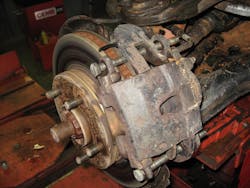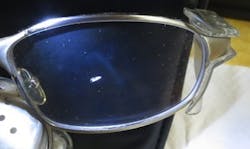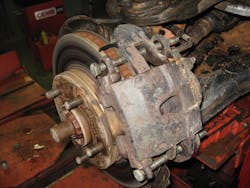When I was a drivability and electronics specialist at a large Ford dealer, the service manager, and shop foreman gave me the first trainee and then another that had almost no foundational knowledge in auto repair. I never figured out why they did that. One of these was a middle-aged, laid-off, small-town policeman who couldn’t learn how to change a serpentine belt, no matter how many times I explained and demonstrated the process. Another trainee was shown how to disconnect the fuel lines to set up the injector cleaner. He had performed that task successfully and repeatedly, but one day he mistook the A/C liquid line for a fuel line on a Bronco II, and you can imagine how that went. It vented refrigerant in a greasy cloud, blowing the orifice tube out into the service lot.
Early advancement on a quest for wisdom
When I was doing fleet maintenance for the five years I worked down on the Texas coast (‘78-‘83), I was responsible for over forty pieces of equipment and had two or three guys for helpers. We maintained cars, pickups, a couple of semi-trucks, an IH Loadstar 1800 gas burner, seventeen forklifts, and three pipe loaders. There was a separate mechanic for our ten cranes, which didn’t bother me at all because I always hated working on cranes.
Anybody who has been in charge of a fleet knows problem-solving and engineering come with the territory. Consequently, I was forced to gather and hone foundational knowledge at that job while keeping all the cars, trucks, forklifts, and pipe loaders in service. It was one of the most incredibly beneficial five years of my entire career.
Having inherited my dad’s propensity to be self-reliant, I was reluctant to borrow tools from anybody and I didn’t like asking others for troubleshooting help either. The shop at that place was in one end of a huge Quonset, but on the other end were the welders, then there were a few electricians and a couple of truck drivers. Except for my helpers, these characters were older guys who tended to mill around my (busy) part of the shop when they weren’t busy. And I was always having to engineer fixes to keep the machinery working. And I managed some successful repairs; some of which my supervisor said weren’t possible.
The road boss shifter fix
One day I found myself dealing with a broken gear shifter on a White Road Boss. The top end of the 7/8-inch steel shifter rod on that truck had been machined down at its tip and cut with 5/8-inch external threads where the big shifter screwed on with its air switches and stuff. As I sat in the driver’s seat pondering the quickest fix, the older guys kept insisting that I’d have to replace the shifter rod. I postulated that I could file the rod flat where the threaded part had popped off, center punches it, drill down into the shaft a couple of inches, tap it with 5/8 threads, and screw in a suitable length of 5/8 threaded rod. The shifter handle with its air valves could then be screwed back on and the truck could be driven almost right away. I decided to try that. They were all shaking their heads.
Well, I made it happen just because they said I couldn’t. And I did it perfectly, all while holding the shifter steady with my right leg wrapped around it and using a heavy half-inch electric drill to create the bore at the end of the shifter, following up by cutting some good solid 5/8 coarse threads. That Road Boss was back on the road making the company money within a half-hour instead of waiting a week for parts. That’s what being a mechanic is all about, you see. We use our foundational knowledge, our smarts, and our strength to keep mechanical stuff going.
With every successful repair, we gain confidence. And let’s face it — building confidence and self-reliance with successful repairs is probably the most necessary foundational strategy for a person who wants to succeed in this or any other field. You have to believe in yourself. It’s as simple as that. And then there are times when a repair (or a series of them) seem to go wrong for us. Just about all seasoned mechanics have experienced those SNAFU jobs, sometimes in series, and it can be psychologically draining. But we need to encourage ourselves like the warriors we are, to rise above the despondence those situations bring, which is a powerful foundational strategy. To quote Zig Ziglar, "Failure isn’t a person; it’s an event."
Need help much?
One of the things I began to notice on that Texas Coast job was how prone some mechanics are to call for the calf rope, while troubleshooting because it’s easier if somebody else figures out what needs to be done. I was probably twenty-one years old with a half-dozen years as a professional wrencher, and Bob (the crane mechanic) was fifty-five at the time, with decades of heavy equipment experience. He was good with nuts and bolts, but he couldn’t troubleshoot a simple charging system.
Likewise, at the dealer, I ran into quite a few guys who were good with nuts and bolts but wouldn’t even try to read a wiring schematic or the vacuum map on a VECI decal. They just about always needed help with those things, it seemed. What I taught my students as a college instructor was that asking for help isn’t a bad thing, but it shouldn’t become a way of life for any professional. That being said, there are times when we all run out of ideas and need another set of eyes or a knowledgeable buddy for a sounding board, to clarify our thoughts. Throughout my automotive career, I found myself learning something new on almost most every troubleshooting experience. And on more than a few occasions, I gladly provided input to help other guys figure out tough ones. Sometimes the dispatcher at the dealer would hand me the phone with a call from across town, across the country, and once from North Africa, to help some Italian mechanics get a Jeep Cherokee going (I’m not kidding). But then there were mechanics I knew who would come to me for help they didn’t need, and when I asked them what the problem was, they’d say: “I haven’t done one like this before.” My problem with that was that with new models coming out every year I found myself doing jobs just about every day that I’d never done before. That’s how real mechanics roll in this business. Just because we’ve never done a job doesn’t mean somebody always has to walk us through it. Granted, some of the module re-flashing we have to deal with on various makes these days may be dicey enough to call for long-distance help, and it’s good to have resources like that.
But be careful of false confidence that can come if we get lucky too many times, by just swapping a part. Even a blind hog finds an acorn sometimes. The sharp guys in this business have a clear and systematic way of figuring things out. They’ve sharpened their troubleshooting skills to find out what’s NOT wrong and then they home in on what the problem is, like missiles on a target. That’s a foundational strategy everybody needs to build.
Listen, be humble, and learn
One day I was teaching my people the method of finding a head gasket leak into the water jacket, where you remove the radiator cap, fill the system to the top with water, and then spin the engine over while watching the water in the filler neck. This is done with all the spark plugs removed, except one. If the cylinder with the spark plug in it had a compression leak into the water jacket, you’d see the water in the filler neck bouncing or bubbling. If it didn’t, you’d move the same spark plug to the next hole and then the next one until you found the breached cylinder.
A 20-year-old know-it-all mechanic in the class disagreed with the method, saying he had “never heard of that,” thus he figured what I was teaching was unnecessary. He claimed a simple radiator pressure test would provide the same information. I asked him a series of questions hoping to lead him to think; a cooling system pressure tester redlines at about 17 psi and might fail to reveal a high-pressure cylinder leak, but a pumping piston on a spinning engine will produce probably ten times as much pressure with the spark plug in place. Even after I explained it that way he still wasn’t convinced – or pretended not to be. We should be open-minded in class, but we also need to ask the right questions to solidify our understanding.
At that fleet maintenance job in Texas, since we had a Delco Parts supplier and I was the foreman with the P.O. book that bought parts, the Delco supplier sponsored a trip for me, to my first real automotive school in 1981. The school was at the GM training center in Houston, Texas where Ellen Smith taught twelve guys in a two-day class, about GM’s Computer Command Control system. I still have the training booklets we got in that class. Thanks to Ellen Smith’s brilliant teaching, I learned what Closed Loop Fuel Control is, how zirconia O2 sensors work and gained a lot of other foundational knowledge other people didn’t have, by just asking her the right questions. Because of that one class, I developed a solid foundational fuel system troubleshooting strategies I’ve used to this day.
What NOT to do
Wearing safety glasses will save your eyes (Figure 1), so do that. Using a good light and finding the right work angle will help prevent blind mistakes. But experience dictates that what we shouldn’t do is as important in some cases as knowing what we should do. A good example of this would be a brake job that comes in with the brake calipers hay wired, duct-taped, etc (Figure 2). And by necessity, we might disassemble those patched-up brakes and write a solid repair estimate, only to have a frugal or cash-strapped customer reject the repairs and tell us to put it all back together with the way it was. Excuse me, but that’s a really bad idea. In that case, the car needs to either go out of there on the hook or it needs to be fixed right. There’s no middle ground. It’s a bad bet to allow a customer to leave your shop with a safety compromised vehicle, even if the customer tells you they want it back that way. And even if they sign a waiver, you’ll still lose in court. Getting away with it a few times is like playing Russian roulette. And if you’re working for a shop owner that doesn’t believe that’s a litigation nightmare, you might want to change jobs.
Another simple example is when we’ve done automatic transmission work and discovered that the transmission might not go into Park or might not stay there. If Park isn’t a solid shifter detent, that vehicle shouldn’t be released to the customer, even if all the other work is done and that’s the only thing wrong with the vehicle. Sometimes we don’t catch that unreliable Park issue until everything else is done and the customer is expecting to have the vehicle back that same morning. In my department, we’ve had to hold customers’ vehicles while we ordered them a $100 shift cable and/or whatever else might be needed to make sure Park was Park. If the vehicle suddenly decides to deselect Park on its own, roll away, and kill somebody, and you released it that way... well, finish the thought. In hill-country, a vehicle that jumps out of the park is even worse than patched brakes. Cars can roll away and kill.
Listen, look and think clearly
There are problems we should spot immediately, like a twisted rubber brake hose rubbing on a CV axle. Then there’s the natural engineer built into every really good mechanic. This would be a guy or gal who has sufficient understanding of the machine, to listen to things others miss, think below the surface, and will ponder why a part of a system was designed and built the way it is. Furthermore, this thinker will sometimes figure out how do make solid, sensible, reliable repairs that are safe and even better than the original design.
One example among hundreds would be the fix some transmission experts came up with on those Nissan RE401 transmissions, where the planetary gearset will last longer if you slightly enlarge that one hole in the separator plate that feeds oil to those overheating gears. It’s a very slight, safe modification that makes good sense.
As for thinking, some jobs will beat you up if you don’t just try a different way of doing the same work. In the late 80s when some 5.8L F150s had all that ridiculously complicated Thermactor Air plumbing next to the plenum, and you couldn’t even see the fuel rail, there was a recall program where we had to replace the original steel fuel pressure regulators with stainless ones. The original steel ones were rusting internally and failing. That fuel pressure regulator is secured to the fuel rail with three Allen head screws, coming in from the bottom and coated with the thread-locker compound. The two other drivability guys I worked with were crabbing about how annoying it was to replace those fuel pressure regulators, with the downward-facing socket head cap screws buried under all that stuff on top of the engine. “I do it with my ¼ inch air ratchet,” I told them offhandedly. They were incredulous and had me demonstrate my method. I used my little air ratchet with a ¼ inch drive T27 Torx bit (which works better on an Allen screw than an Allen wrench), reached under all that plumbing, found the screws, and had the regulator in my hand in 30 seconds. The point of that exercise is that you don’t know if something will work until you give it a try.
Concluding thoughts
My career started when I was a young teenager in the early 70s, working for my dad at his garage; I cut my professional teeth on wrenches and ball bearings while smelling gasoline and grease, and washing my hands with GoJo and Lava soap. One of the earliest things I learned was not to waste time when work needs doing (Figure 3). But in closing when it comes to foundational strategies, I’d just say “Learn to use your head.” Visual inspections are good, but don’t try to wing it on the repair, and don’t make assumptions when you can gather real data. Read schematics and shop manual procedures carefully. Have the tools to gather good readings and scope patterns, and become a service bay detective. Cover all the bases.
One guy called me for advice on a no-start, and I told him to scope his crank sensor. He had a scope but tried other things (for a full month) before he finally scoped the CKP sensor. He found that he had broken a tooth from the 36 minuses 1 reluctor while doing some torch work on the timing cover.
Don’t neglect voltage drop tests (Figure 4). Check the fuses and do a good visual inspection before you replace parts or fiddle with wire harnesses, else you may accidentally and temporarily fix one that’ll wind up coming back. I’ve seen transmission problems fixed by a single fuse after a transmission rebuild and six weeks of unsuccessful guessing.
I knew of a dealership in Texas that shamefully charged $1700 to fix a government SUV. After their mechanic chased a problem for a week, it was found in the end, to be caused by a single fuse that had been removed by a government mechanic, while he was installing a light bar. Again, check the fuses first, then powers and grounds.
On engine repairs, do the cheap and easy stuff first. If you’re working on a mysterious overheater, try a thermostat first and then bypass the heater core with a clear hose (to check the water pump action) before you unnecessarily pull the cylinder head. If you do pull the head and find the problem, don’t call that overheating engine fixed without finding out why it overheated in the first place. Remember “Cause and Effect.” A repeat performance of that overheat, because you missed an intermittent fan problem, makes for a record-breaking comeback.
Focus on the customer’s primary complaint before you go off on a tangent. While that might sound simplistic, such tangents happen.
Case in point: One owner told me he had taken his Cavalier to the Chevy dealer in another town and had it written up for “overheating.” The mechanic noticed a misfire and got side-tracked chasing that for some reason. The car was running smoothly when the mechanic finished but the overheating problem had never been addressed in the service bay. The owner never read the bill. He paid and never even knew his $500 went to fix an engine skip that wasn’t even written up on the repair order. He just headed home, and the Cavalier overheated and destroyed the engine, beyond all repair.
Finally, don’t make a habit of borrowing tools or anything else from other mechanics. That’s unprofessional, unnecessary, and unwise. Be your own person, buy your own tools, and do your work with integrity. If you’re a shop owner, use a good labor guide, be fair, and don’t overcharge for your work. Always admit your mistakes and strive to make things right, when mistakes happen. That’ll put your head and shoulders above more people than you can imagine in just about any business.





